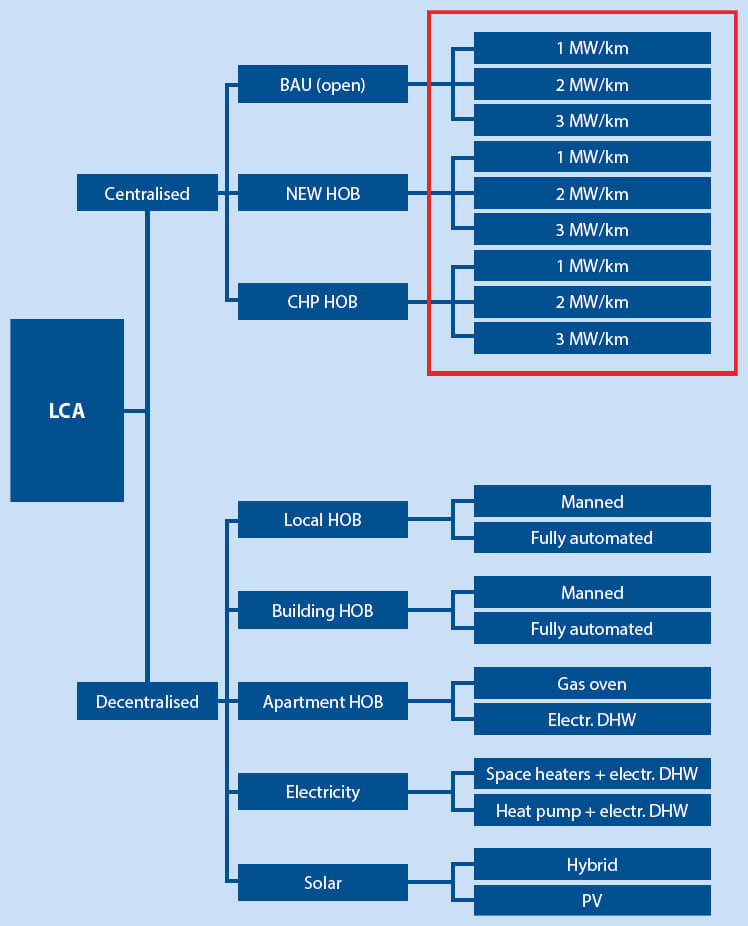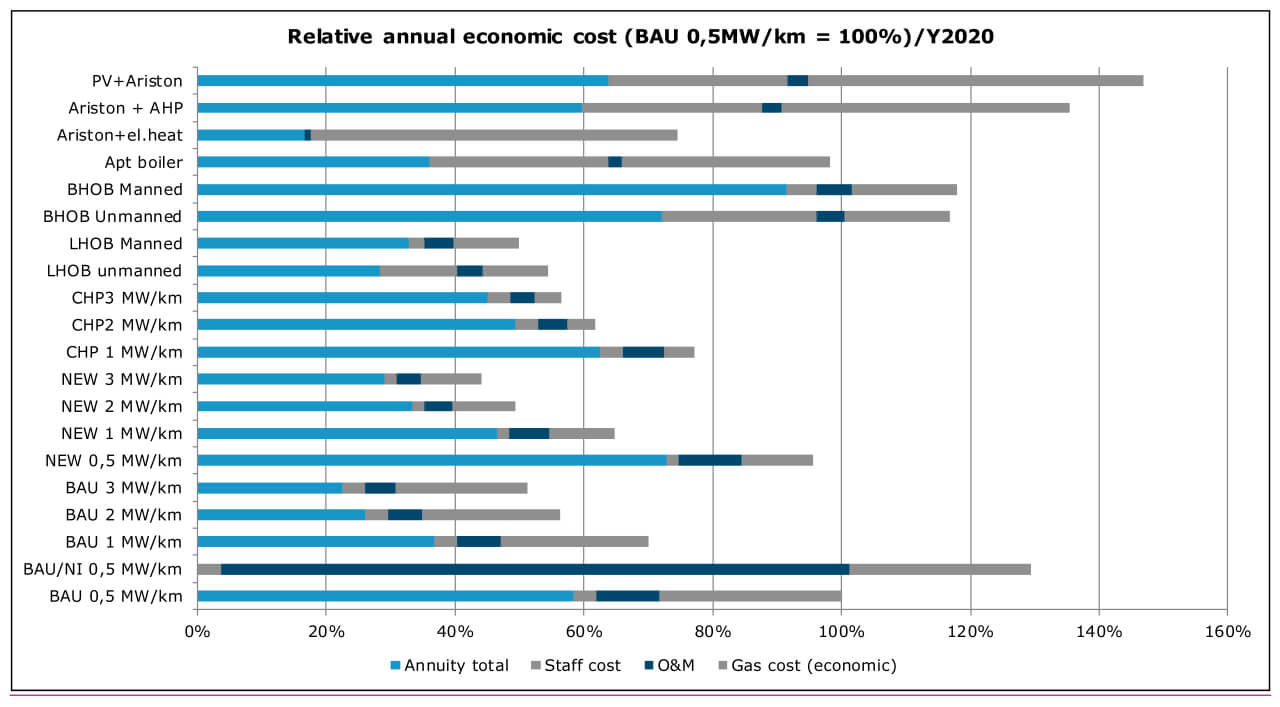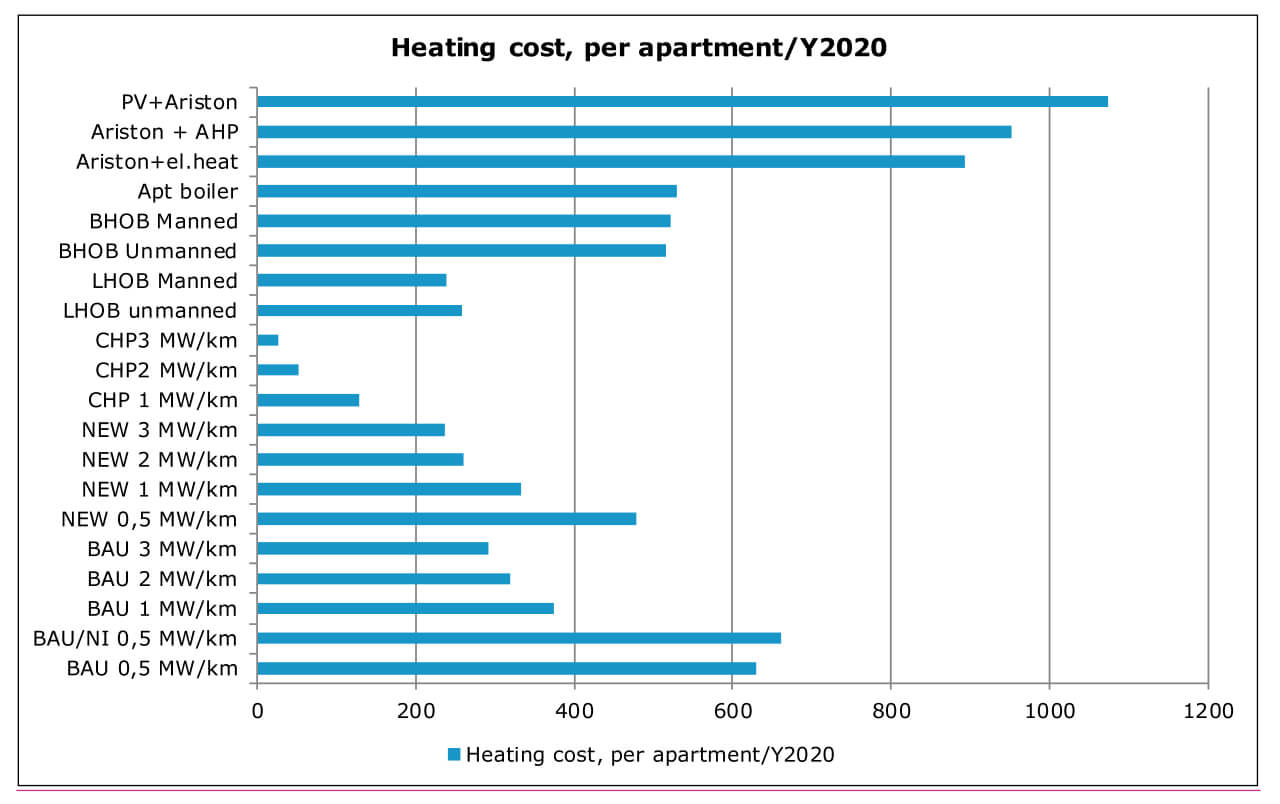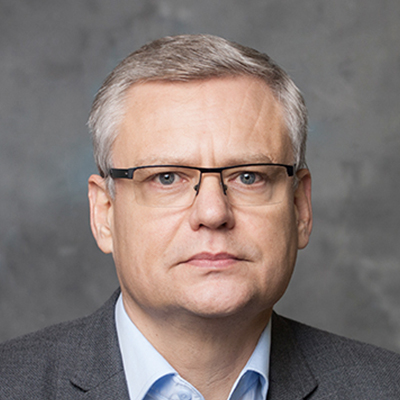14/01/2021
Determining the least-cost district heating alternatives
International financial institutions (IFIs) play a major role in social and economic development programs in developing and transition economies such as Belarus, Kyrgyz Republic, Tajikistan and Uzbekistan. This role includes project development, project funding and assisting beneficiaries (e.g., energy companies) in project implementation.
Abbreviations
DH = District Heating
CHP = Combined Heat and Power
HOA = Homeowners’ Association
MAB = Multi-Apartment Building
LCA = Least Cost Analysis
COP= Coefficient of Performance (efficiency) used for heat pumps
ToR = Terms of Reference
DHW = Domestic Hot Water
HOB = Heat Only Boiler
BAU = Business as usual
Such investments and funding are usually tied to specific projects that focus on sustainable development. Elomatic’s IFI team provides technical and advisory assistance to IFIs and beneficiaries by conducting extensive technical studies on development issues.
The key task in large investment projects is determining project feasibility. This article focuses on the issues related to identifying which heating method would be the least costly solution for these countries at the city level. We call this analysis the Least-Cost Analysis (LCA), and it is essential for District Heating (DH) feasibility studies.
Conducting LCAs requires careful deliberation and a solid track-record of working in transition economies. On the one hand, holistic, multivariate analyses, like the LCA, form the basis of many IFI projects, because they can be used to determine the best ways to plan and to implement effective development.
On the other hand, effective LCAs consider the often-complex local contexts for the IFI projects themselves. Positive economic development in transitional economies has been hampered by underdeveloped local infrastructure, small domestic markets, limited access to world markets and competition from more attractive destinations for foreign direct investments. These issues are exacerbated further by byzantine heat tariff regulations and a planned economy style of governance. Energy production solutions also have far-reaching social consequences, as a sizable part of the population of transition economies is affected by poverty.
A scarcity of available funding forces energy companies to continue their operations without substantial investments to outdated systems, which may cause wealthy customers to change to individual heating systems. In the long-term, this may eventually result in the defunding and closure of the more affordable centralized system.
Therefore, to support decision makers, an objective way of analysing the different options is needed. For such assignments, Elomatic uses its own LCA Method. This method follows the processes determined in the relevant standard (EN ISO 14066:2006) but has the added advantage of being fully targeted to the specific topic of energy costs.
The LCA is a simplified and systematized way of comparing the socio-economic costs of different heat supply alternatives at multiple levels. The method has some limitations: The model considers the costs of the alternatives but not the revenues (except for the value of heat produced). Costs are also considered as evenly distributed over the lifetime of the system and do not include taxes, subsidies and project-specific financial costs. The LCA is therefore not a tool for assessing project viability.
The confidence level of the results of the analysis is directly dependent on the quality of the modelling inputs. The variables, such as investment and fuel costs, wind and solar resources, environmental costs and so forth, are determined by the local or project specifics.
Service quality is an issue in transition economies and the goals for the Best Available Technologies proposed by the LCA are presented in Table 1.
| Topic | As of today | Target |
|---|---|---|
| Heating |
|
|
| DHW |
|
|
| Pricing |
|
|
| Billing |
|
|
| Technical Support |
|
|
| Risks |
|
The best and first step should address lowhanging fruits, like system inefficiencies.
1st Question: The Point of view
An informed choice of perspective is essential for an effective LCA result. Depending on the point of view, the outcomes of the analysis may diverge or even be at odds between stakeholders. The stakeholders include the country, city, heating company, homeowners’ association (HOA) and the tenant.
Typically, the analyses in IFI feasibility studies are made at two levels: the country and the tenant.
At the country level, stakeholders are mainly concerned with the benefits across the whole economy, like foreign trade balance (import/export of goods, energy), primary fuel consumption, investments, employment, living conditions of the population and the impact on health and social equality.
For example, when calculating the primary fuel consumption, the country level analysis also needs to take into consideration the whole electricity system.
The tenant, conversely, is interested in decreasing their payments for heat and electricity, in their own investments and their living conditions. Unlike in the Nordic countries, in the target countries an apartment, i.e., a tenant, is the direct customer of the DH company. Consequently, in some countries legislation allows individual apartments to disconnect from the heating system.
Transition economies often suffer from an electricity deficit; hence the model also considers the known benefits of Combined Heat and Power (CHP) production compared to heat-only production.
In Finland, Elomatic conducts similar studies, but mainly for different stakeholders. These might be cities aiming at carbon neutrality, DH companies planning their long-term investment/fuel sourcing, or homeowners’ associations considering disconnecting from the DH system in favour of hybrid heating systems (e.g., ground heat pumps).
2nd Question: Centralization
In densely populated cities, DH together with CHP production has been demonstrated to be the least costly heating option in the long run. The comparable benefits of centralized DH accrue from:
- high energy efficiency due to integrated systems,
- fuel type flexibility,
- effective flue gas cleaning benefiting from economies of scale
The design of the DH systems in transition economies is rather uniform and is based on old Soviet-era standards that are often inconsistent with modern international practices. In many instances, neglected maintenance has resulted in deterioration, which causes high operational losses, low availability and poor performance, particularly since the collapse of the Soviet Union.
DH is commercially viable and competitive compared with other heating methods in open markets where prices are not regulated and DH is produced with cheap fuel, and/or provided through efficient CHP production. For a centralized DH system, heat density is the benchmark value: the higher the density, the more efficient the system.
If, however, the population density of the area studied is not enough, the LCA model will recommend other solutions.
In each case, the technological heat supply alternatives vary. The number of alternatives may be high as shown in Figure 1.

3rd Question: Method
It is ineffective to carry out an LCA for each individual building or for an entire city. The IFI team uses the following method:
- Calculations are made only for multi-apartment buildings, those that are standardized after the post-Soviet era
- Based on the inventory of the building stock in a city, 1-2 typical building-types are selected
- Heat demand (kW) and heat consumption (MWh per annum) are calculated based on real building data (building structures, U-values, number of apartments, number of tenants, specific water consumption per tenant, etc.)
- Specific consumption data is determined (W/m3, kWh/m3)
- Calculations are carried out for an imaginary area consisting of 200 buildings for the DH concept, respectively 10 buildings for the Area Heating concept
- Special attention is paid to network heat density (MW/km) as one of the most important parameters.
Normally, calculations are done using the business-as-usual baseline (BAU, current system). Due to the obsolescence of the existing system, all new alternatives might seem lucrative.
A full-scale least-cost analysis requires substantial information about all available systems. In transition economies, reliable metered information is often scarce and unreliable. Therefore, demonstrable previous experience of DH in transition economies is central to determining key values and performance indicators in an effective manner.
Typical Key Performance Indicators (benchmarks) for the DH system include, for instance:
- Efficiencies in general
- The sources of marginal electricity
- The specific CO2 emission value for grid electricity
- Climatic conditions
- Current and future tariffs and prices
- Socio-economic aspects, like the availability of DHW during summer and affordability
- Investment costs for each possible component, for instance strengthening of the electrical networks in the buildings
- Necessary spare & peak capacity to be included
- O&M cost and staff costs
- Estimated lifetime for each component
4th Question: Analysis
The interpretation of LCA results is not a simple matter. The model does not provide absolute answers but offers a tool for unifying different alternatives for the purpose of comparison.
Figure 2 shows an example of country level results as relative annual heating costs compared to BAU. The second result at the country level is the primary fuel consumption and related CO2 emissions.

Figure 3 shows an example of the results of the analysis at the tenant level as absolute annual heating costs including annualized investment costs.

In transition economies, the first obvious step – to decrease primary fuel consumption and CO2 emissions – would be an improvement of the efficiency of the whole value chain. Knowing their least-cost heating solution allows transitional economies to influence the future development of their energy sectors in meaningful ways.
A least-cost heating solution will also allow economies to ensure affordable and reliable energy. With salaries as low as 100 USD per month, an annual heating cost of 1000 USD equals 40% of the income of the society’s poorest segments. A good quality of service will also deter wealthier customers from disconnecting from the DH system, which in turn allows DH companies to make enough revenue for continued production.
Conclusions and future trends
Transition economies are usually highly centrally governed. Many of them are currently developing their heating strategies. This work requires a good empirical understanding of different heating scenarios.
The best and first step should address the low-hanging fruits, like system inefficiencies. If the current centralized system is both inefficient (expensive) and unreliable, any new solution might seem better, at least from the tenant’s point of view. The LCA is aimed at ensuring that heating solutions consider the prevailing situation in ways that minimize costs and maximize benefits.
A future application for the LCA is in forecasting future developments in energy production. The current trend of global warming indicates that summertime temperatures in some countries will become almost intolerable. A significant rise in demand for space cooling is therefore likely imminent. But why not pay the small marginal price and buy cooling devices that can also be used for heating purposes with high COP.
About the authors
The authors are members of the Elomatic IFI Team. The IFI team, based at Elomatic’s Espoo office, is specialized in the assignments financed by International Financial Institutions such as the World Bank or EBRD. Services include Feasibility studies, Corporate Development or Project Management services (design, procurement, site supervision, commissioning) during the project implementation.



